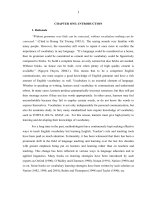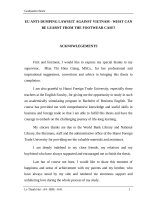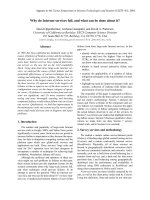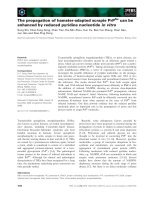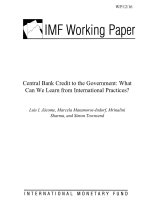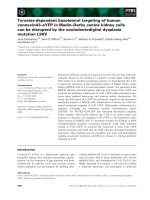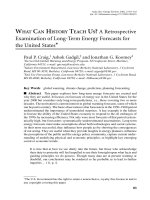EU ANTI-DUMPING LAWSUIT AGAINST VIETNAM - WHAT CAN BE LEARNT FROM THE FOOTWEAR CASE
Bạn đang xem bản rút gọn của tài liệu. Xem và tải ngay bản đầy đủ của tài liệu tại đây (338.99 KB, 66 trang )
Website: Email : Tel (: 0918.775.368
EU ANTI-DUMPING LAWSUIT AGAINST
VIETNAM - WHAT CAN BE LEARNT FROM
THE FOOTWEAR CASE?
ACKNOWLEGEMENTS
First and foremost, I would like to express my special thanks to my supervisor, Phan
Thi Hien Giang, MSCs., for her professional and inspirational suggestions, corrections and
advice in bringing this thesis to completion.
I am also grateful to Hanoi Foreign Trade University, especially those teachers at the
English Faculty, for giving me the opportunity to study in such an academically stimulating
program in Bachelor of Business English. The course has provided me with comprehensive
knowledge and useful skills in business and foreign trade so that I am able to fulfill this thesis
and have the courage to embark on the challenging journey of life-long learning.
My sincere thanks are due to the World Bank Library and National Library, the
librarians, staff and the administrative office of the Hanoi Foreign Trade University for
providing me the valuable materials and assistance.
I am deeply indebted to my close friends, my relatives and my boyfriend who have
always supported and encouraged me to finish the thesis.
Last but of course not least, I would like to share this moment of happiness and sense
of achievement with my parents and my brother, who have always stood by my side and
rendered me enormous support and unfaltering love during the whole process of my study.
Le Thanh Hai - A4 - BBE - K41 1
Website: Email : Tel (: 0918.775.368
ACKNOWLEGEMENTS................................................................................1
INTRODUCTION............................................................................................4
Background to the study....................................................................................................4
Objective of the study........................................................................................................4
Research questions.............................................................................................................5
Structure of the thesis.........................................................................................................5
Scope of the study..............................................................................................................5
Research methodology.......................................................................................................5
Chapter 1...........................................................................................................7
LITERATURE REVIEW................................................................................7
1.1. Dumping in international trade...................................................................7
1.1.1. Definition.................................................................................................................7
1.1.2. Impacts on importing countries and international trade..........................................8
1.1.2.1. Impacts on importing countries.......................................................................8
1.1.2.2. Impacts on international trade .........................................................................8
1.2. Anti-dumping law..........................................................................................9
1.2.1. WTO's anti-dumping law.........................................................................................9
1.2.1.1. Determination of dumping.............................................................................10
1.2.1.2. Anti-dumping measures.................................................................................14
1.2.2. EU's anti-dumping law...........................................................................................16
1.2.2.1. Determination of dumping.............................................................................17
1.3. Comparison between WTO and EU anti-dumping laws..........................22
Chapter 2.........................................................................................................25
THE FOOTWEAR CASE.............................................................................25
2.1. Overview of the Vietnam footwear industry.............................................25
2.1.1. The importance of Vietnam’s footwear industry..................................................25
2.1.2. Footwear exports to the European Union..............................................................29
2.2. Overview of the EC's anti-dumping petition.............................................30
2.3. The petitioner's arguments.........................................................................32
2.3.1. Market economy treatment ...................................................................................32
2.3.1.1. Business decisions..........................................................................................34
2.3.1.2. Accounting.....................................................................................................35
2.3.1.3. Assets and 'carry over'....................................................................................35
2.3.1.4 Legal environment and currency exchange....................................................36
2.3.2. Individual treatment...............................................................................................36
2.3.3. Vietnam's selling under the normal value.............................................................37
2.3.4. Injury .....................................................................................................................38
2.3.4.1. Macro-economic indicators...........................................................................39
2.3.4.2. Micro-economic indicators............................................................................41
2.4. The subject country's arguments...............................................................42
2.4.1. Market-economy treatment ...................................................................................43
2.4.2. Level of ‘injury’ to EU producers.........................................................................44
2.4.3. Inappropriate choice of surrogate country.............................................................48
2.4.4. Effects on interest of the Community....................................................................49
2.5. Summary......................................................................................................50
Le Thanh Hai - A4 - BBE - K41 2
Website: Email : Tel (: 0918.775.368
On the 4th of October, 2006, the EC made their final decision on leather
footwear anti-dumping case against Vietnam. An official anti-dumping
duty of 10% has been imposed on uppers leather footwear from Vietnam
in the period of 2 years...................................................................................52
Chapter 3.........................................................................................................53
RECOMMENDATIONS AND LESSONS LEARNT.................................53
3.1. Conclusions and recommendations............................................................53
3.1.1. Diversify the markets outside the EU....................................................................55
3.1.2. Diversify the product range...................................................................................56
3.1.3. Enhance model of business transfer......................................................................57
3.1.4. Improve competitiveness.......................................................................................58
3.2. Lessons learnts.............................................................................................59
3.2.1. Fully understanding on international trade law concerning dumping issue.........59
3.2.2. Strengthen market economy in Vietnam...............................................................61
3.2.3. Domestic enterprises must be well-prepared ........................................................62
3.2.4. Create good public relation....................................................................................63
CONCLUSION...............................................................................................64
BIBLIOGRAPHY..........................................................................................65
Le Thanh Hai - A4 - BBE - K41 3
Website: Email : Tel (: 0918.775.368
INTRODUCTION
Background to the study
In recent years, a great number of bilateral and multilateral trade agreements have been
signed between Vietnam and other countries and international organizations, which, among
other things, have provided greater access for Vietnamese goods to the global market.
However, several kinds of Vietnam exports have been accused of being sold at dumped
prices in some foreign markets. In particular, anti-dumping tariff was imposed on Vietnam by
the European Union on glutamate in 1998, by Poland on gas lighter in 2000, by Canada on
garlic in 2002, by the US on catfish in 2002, shrimp (2003), woodwork (2004) and again by the
EU on bicycles in 2004. On July 2005, the European Commission officially lodged yet another
dumping lawsuit against Vietnamese footwear products exported to the EU market. Such series
of lawsuits has raised massive concern for Vietnamese producers, as it has had a negative
impact on international economic integration process of Vietnam, as well as shown that
Vietnam has not adequately prepared for a bigger "playing field".
Active integration inevitably entails proactive study about foreign markets. Nevertheless,
international markets in general, and the EU market in particular have different regulations and
trading practice that requires deep understanding to defend oneself from implicit risks.
Although dumping and anti-dumping suits are not something new to Vietnam as it was several
years ago, and Vietnam has been moving on a very steep learning curve, it is still necessary for
Vietnamese enterprises to deepen their understanding by further analysis if they are to avoid
anti-dumping petition as they break into markets abroad.
Objective of the study
This graduation paper, therefore, aims to furnish Vietnamese exporters and concerned
government agencies with a structured approach to anti-dumping lawsuits by contributing a
closer look at anti-dumping regulations and experience from the footwear case. With this study,
Vietnamese exporters will hopefully be able to gain the essential ‘weapon’ to defend
themselves when there is a complaint filed against them, and more importantly, to avoid being
challenged and getting exhausted in the daunting investigation and lawsuit process.
Le Thanh Hai - A4 - BBE - K41 4
Website: Email : Tel (: 0918.775.368
Research questions
The key question is: "How can Vietnamese exporters prove that Vietnam leather footwear is
not being dumped into the EU market?" To seek answer to the question, the following sub-
questions will be addressed:
- What are the differences between antidumping law of WTO and that of the EU?
- How did the EC accuse Vietnam of dumping leather footwear in the EU market?
- What were the arguments used by Vietnam in the footwear lawsuit?
- What are the lessons learnt for Vietnam for future dumping and antidumping lawsuits?
Structure of the thesis
To achieve the above objectives, the thesis is divided into of three chapters. Chapter 1
lays the theoretical ground for the paper by defining the two concepts: dumping and anti-
dumping, and presenting different perspective of anti-dumping according to GATT/WTO,
and the EU. Chapter 2 will then move on with an actual case study: the footwear case. It
begins with an overview of the footwear industry in Vietnam, and then provides a detailed
description and analysis of the footwear dispute procedure, the arguments used by two sides:
the EU and VN. Finally, the last chapter will conclude the paper with some recommendations
for settling other dumping disputes in the future; for avoiding anti-dumping lawsuit; and
avoiding negative consequences from the case.
Scope of the study
Dumping and anti-dumping lawsuits are a very broad topic. However, this study only
focuses on a particular case: the VN - EU dispute on leather footwear. This will serve as an
empirical but structured approach that Vietnamese current and potential export enterprises
need to familiarize with if they are to survive and succeed in the international market.
Research methodology
Le Thanh Hai - A4 - BBE - K41 5
Website: Email : Tel (: 0918.775.368
The report draws heavily on desk research, with data and information obtained from
the Official Journals of the European Union, Action Aids Vietnam, the Vietnam Leather and
Footwear Association, official and unofficial reports, various comments and figures from
published studies by experts in the field, newspapers, magazines, and the Internet. This is
supplemented by primary information and experience gathered in the field verification
exercise by the EU investigators to the footwear enterprises in Vietnam in the summer of
2005.
Le Thanh Hai - A4 - BBE - K41 6
Website: Email : Tel (: 0918.775.368
Chapter 1
LITERATURE REVIEW
1.1. Dumping in international trade
1.1.1. Definition
According to article 2, part 1 of the agreement on implementation of article VI of the
general agreement in tariffs and trade 1994, "a product is to be considered as being dumped,
i.e. introduced into the commerce of another country at less than its normal value, if the
export price of the product exported from one country to another is less than the comparable
price, in the ordinary course of trade, for the like product when destined for consumption in
the exporting country". A question is raised: what are the reasons of dumping activities in
international trade?
In today’s global game of intense competition, dumping helps enterprises easily break
into and then dominate other markets. However, there are differences between the aim of big
companies and small ones, developed countries and developing ones. In respect of small
companies and developing countries, their products are less competitive and they have to
dump in an effort to sell their goods. With regard to big firms and developed nations, they
sell at a low price on importing markets to gain market share, furthermore, to kick out
competitors, and gradually dominate the importing markets. Once breaking into importing
markets, exporters are able to completely control them by low a price that is the target of
dumping activities. Secondly, in case countries are shortage of foreign currencies, they may
foster export by lowering goods' prices. However, dumping may happen beyond the control
of producers, exporters in some cases, for instance: bottle-neck, supply exceeds demand,
damageable inventory, etc.; they have to sell goods at lower prices to recover their capital.
Le Thanh Hai - A4 - BBE - K41 7
Website: Email : Tel (: 0918.775.368
In short, there are many purposes to dump, but whatever purposes they have, dumping
still causes bad effects on importing countries, others nations, and international trade.
1.1.2. Impacts on importing countries and international trade
1.1.2.1. Impacts on importing countries
Nowadays, dumping activities are becoming popular in the context of international
trade. Eliminating fair competition to break into markets, dumping has turned into an
obstacle against the trend of trade liberalization. In the short term, consumers gain benefit
from dumping because of cheap price. However, this is an unfair competition activity; it can
seriously damage domestic production of importing countries in the long term. As a result,
nations around the world try to fight against dumping in an attempt to prevent or minimize
dumped goods on their markets in case the imports of that type of goods have caused or
threaten to cause damage to a substantial part of the domestic industry.
1.1.2.2. Impacts on international trade
In the short term, dumping helps transaction of goods on international trade increase in
quantity. Normally, dumping enterprises intend to take over foreign markets, i.e. competing
with domestic producers or importers from other countries for market share. As selling price
is lower than equilibrium price on the market, in accordance with the law of supply and
demand, there will be a new equilibrium point, and an increase in quantity demanded that
will be met by exporters. Therefore, an increase in quantity demanded will lead to an increase
in quantity supplied, that means international trade will develop.
In the long term, when dumping enterprises control markets, and then raise selling
prices, quantity demanded will decrease gradually, and so does trading volume. Otherwise,
domestic enterprises better their competitive ability; vie with foreign exporters for market
share. If government of import country imposes anti-dumping tariff, import goods will no
longer be attractive for low price, so import quantity will reduce.
Le Thanh Hai - A4 - BBE - K41 8
Website: Email : Tel (: 0918.775.368
Dumping always bring benefit for consumers as lower price, wide selection of cheap
and diversified import goods. On the contrary, domestic producers suffer losses. Moreover,
workers will lose their jobs because of reducing production, or bankruptcy. If the interests of
consumers are bigger than the ones of home producers and the unemployed, the society still
benefits. On making decision of whether to levy anti-dumping tariff or not, many nations
consider this element.
Dumping and anti-dumping measures are controversial and complicated issues that
result in strained international trade relations, hinder WTO's target in establishing a
transparent, equal international business environment.
1.2. Anti-dumping law
As analyzed above, if the export price of a product exported from one country to
another is less than a comparable price, in the ordinary course of trade, for the like product
when destined for consumption in the exporting country. Therefore, by imposing anti-
dumping measures against foreign exporters, importing countries want to prevent exporters
from selling goods at price below its normal value. The main purpose of the imposition of
anti-dumping measures is to protect the domestic economy and home production from unfair
competition, furthermore, to create fair competition environment, a vital factor for trade
liberalization. Consequently, anti-dumping measures are said to be necessary, as they set up
the legal framework in which all players enjoy fair competition. Contrary to the above
purposes, domestic firms can strategically use this measure to target only foreign firms they
view as competitive rivals, some nations abuse anti-dumping measures to protect domestic
production which lead to commercial dispute. As a result, it is necessary to study dumping
and anti-dumping law to take part in international trade.
1.2.1. WTO's anti-dumping law
The Agreement on Implementation of Article VI of GATT 1994, commonly known as
the Anti-dumping Agreement, is a suggestive document for nations to refer to when they set
Le Thanh Hai - A4 - BBE - K41 9
Website: Email : Tel (: 0918.775.368
up their own anti-dumping law. However, WTO's members have to obey Anti-dumping
Agreement.
The Anti-dumping Agreement includes:
- Regulations on content: detailed provisions about methods and criteria for
determination of dumping, injury, causal link between the dumped imports and the alleged
injury.
- Regulations on procedure: provisions about investigation and anti-dumping duties
imposition.
- Regulations on dispute settlement among WTO's members concerning anti-dumping
issues.
- Regulations on competence of Committee on Anti-dumping Practices
1.2.1.1. Determination of dumping
A dumping case will be determined by comparing the export price and the normal
value of the product.
Export price
Export price is the selling price from country of origin or exporting country to
importing country. There are two ways of calculating export price:
- Export price is the transaction price between producer or exporter of exporting
country and importer of importing country.
- The export price may be constructed on the basis of the price at which the imported
products are first resold to an independent buyer, or if the products are not resold to an
Le Thanh Hai - A4 - BBE - K41 10
Website: Email : Tel (: 0918.775.368
independent buyer, or not resold in the condition as imported, on such reasonable basis as the
authorities may determine.
To apply the first method, there are two conditions: Export price is existing (product is
exported under sales contract between producer/exporter and importer); export price is
reliable (price is quoted in a normal sales contract). Documents like commercial invoice, bill
of lading, letter of credit... can be used to specify export price. Nevertheless, the export-
import activities are not always performed under the basis of a foreign trade sales contract
(for instance: export is to move goods from headquarter in one country to its agents in
another one, barter contract). Accordingly, there will be no transaction price to define export
price. Or price quoted in the contract is unreliable because of association or a compensatory
arrangement between the exporter and the importer or a third party. In these cases, the second
method will be used.
The normal value
"The normal value is the selling price of the like product on exporting market".
According to article 2.6 Anti-dumping Agreement "like product" ("produit similaire") shall
be interpreted to mean a product which is identical, i.e. alike in all respects to the product
under consideration, or in the absence of such a product, another product which, although not
alike in all respects, has characteristics closely resembling those of the product under
consideration. The Agreement provides three methods to calculate a product’s “normal
value”.
- The first is the main one which is based on the price in the exporter’s domestic
market. In case of dependent relations between producer and distributor in the exporting
country (so producer can offer cheaper price to distributor), the authorities of the importing
country may take selling price offered by distributor to the first independent importer to be
the normal price.
- The other two methods are alternatives. they are used when there is no domestic price
of the like product in the expiring country for the following reasons: a) When there are no
Le Thanh Hai - A4 - BBE - K41 11
Website: Email : Tel (: 0918.775.368
sales of the like product in the ordinary course of trade in the domestic market of the
exporting country; b) product is sold in the domestic market in special condition; c) the
volume of the sales in the domestic market of the exporting country is low (less than 5% in
comparison with the quantity of the like product sold in the importing market), however, in
case it is proved that the quantity of the sold product in domestic market is enough to
compare with the export price reasonably, the investigating can use the selling price of the
like product to define the normal value. The two alternatives are:
+ A comparable price of the like product when exported to an appropriate third
country, provided that this price is representative
+ the “constructed value” of the product, which is calculated on the basis of the cost of
production, plus selling, general, and administrative expenses, and profits. Costs shall
normally be calculated on the basis of records kept by the exporter or producer under
investigation, provided that such records are in accordance with the generally accepted
accounting principles of the exporting country and reasonably reflect the costs associated
with the production and sale of the product under consideration. Authorities shall consider all
available evidence on the proper allocation of costs, including that which is made available
by the exporter or producer.
If the like product is exported from a non-market economy (the selling price and input
price are set by the government), the above methods are not used to determine the normal
value. Under this circumstance, the Anti-dumping Agreement allows the authorities to use
the selling price or production cost of a third country to calculate the normal value of the
product under consideration.
The ordinary course of trade
There is no specific definition of what sales of the product in the ordinary course of
trade are. however, the Anti-dumping Agreement defines a specific circumstance in which
sales of the like product in the domestic market of the exporting country or sales to a third
country at prices below per unit (fixed and variable) costs of production plus administrative,
Le Thanh Hai - A4 - BBE - K41 12
Website: Email : Tel (: 0918.775.368
selling and general costs may be treated as not being in the ordinary course of trade. The like
product may be disregarded in determining normal value only if the authorities determine that
such sales are made within an extended period of time (normally one year and no less than 6
months) in substantial quantities and are at prices which do not provide for the recovery of all
costs within a reasonable period of time. If prices which are below per unit costs at the time
of sale are above weighted average per unit costs for the period of investigation, such prices
shall be considered to provide for recovery of costs within a reasonable period of time, the
sales is considered to be in the ordinary course of trade.
Calculating the dumping margin
A fair comparison shall be made between the export price and the normal value to
define dumping margin. The comparison must obey these rules:
- This comparison shall be made at the same level of trade (for e.g.: ex-
factory/wholesale/retail price). Normally, the ex-factory price is chose to compare.
- Sales are made at as nearly as possible the same time.
- differences in conditions and terms of sale, taxation, levels of trade, quantities,
physical characteristics, and any other differences which are also demonstrated to affect price
comparability shall be considered.
Three methods are provided to make comparison:
- A comparison of a weighted average normal value with a weighted average of prices
of all comparable export transactions
- A comparison of normal value and export prices on a transaction-to-transaction basis
- a weighted average basis may be compared to prices of individual export transactions
if the authorities find a pattern of export prices which differ significantly among different
Le Thanh Hai - A4 - BBE - K41 13
Website: Email : Tel (: 0918.775.368
purchasers, regions or time periods, and if an explanation is provided as to why the above
two methods can not take these differences into account appropriately.
1.2.1.2. Anti-dumping measures
Provisional measures
Provisional measures aim at preventing injury being caused during the investigation.
They can be brought into effect in the investigation period, provided that: a) a preliminary
affirmative determination has been made of dumping and consequent injury to a domestic
industry; b) the authorities judge such measures necessary to prevent injury being caused
during the investigation; c) an investigation has been initiated, a public notice has been given
to that effect and interested parties have been given adequate opportunities to submit
information and make comments. Provisional measures may take the form of:
- A provisional duty
- A security - by cash deposit or bond - equal to the amount of the anti-dumping duty
provisionally estimated
- Withholding of appraisement provided that the normal duty and the estimated amount of the
anti-dumping duty are indicated.
Provisional measures must not be greater than the provisionally estimated margin of
dumping. Among the above measures, the Anti-dumping Agreement encourages countries to
apply the second one. In fact, almost all nations use this measure because of its simple
procedure.
Price undertakings
Le Thanh Hai - A4 - BBE - K41 14
Website: Email : Tel (: 0918.775.368
According to the Anti-dumping Agreement, during the procedural process, the
authorities and producers, exporters can reach an agreement in price undertakings. "Price
undertakings are commitments under which producers; exporters will revise their prices or
cease exporting dumped goods. Undertakings are voluntary arrangements among producer,
exporter, and importer".
Price undertakings shall not be sought or accepted from exporters unless the authorities
of the importing country have made a preliminary affirmative determination of dumping and
injury caused by such dumping. Price undertakings may be suggested by the authorities of the
importing country, but no exporter shall be forced to enter into such undertakings. Normally,
the authorities of importing country will accept price undertakings offered by exporter, if the
undertakings can remove the injury caused by dumped imports If an undertaking is accepted,
the investigation of dumping and injury shall be continued if the exporter so desires or the
authorities so decide. In such a case, if a negative determination of dumping or injury is
made, the undertaking shall automatically lapse.
Anti-dumping duties
If goods is found to be dumped and causing injury for domestic industry, the decision
whether or not to impose anti-dumping duty, and the decision whether the amount of the anti-
dumping duty to be imposed shall be the full margin of dumping or less are to be made by the
authorities of the importing country. The Anti-duping Agreement suggests that the duty be
less than the margin if such lesser duty would be adequate to remove the injury to the
domestic industry.
When an anti-dumping duty is imposed in respect of any product, such anti-dumping
duty shall be collected in the appropriate amounts in each case, on a non-discriminatory basis
on imports of such product from all sources found to be dumped and causing injury, except
imports from those sources from which price undertakings have been accepted.
The amount of the anti-dumping duty shall not exceed the margin of dumping, but the
duty can be less than the margin if it can remove the injury to the domestic market.
Le Thanh Hai - A4 - BBE - K41 15
Website: Email : Tel (: 0918.775.368
If a product is subject to anti-dumping duties in an importing country, the authorities
shall promptly carry out a review for the purpose of determining individual margins of
dumping for any exporters or producers in the exporting country who have not exported the
product to the importing country during the period of investigation, provided that these
exporters or producers can show that they are not related to any of the exporters or producers
in the exporting country who are subject to the anti-dumping duties on the product. Such a
review shall be carried out on an accelerated basis, compared to normal duty assessment and
review proceedings in the importing country. No anti-dumping duties shall be levied on
imports from producers and exporters while the review is being carried out. The authorities
may, however, remain appraisement and/or request guarantees to ensure that if such a review
results in a determination of dumping in respect of such producers or exporters, anti-dumping
duties can be levied retroactively to the date of the initiation of the review.
Anti-dumping duty shall be terminated on a date not later than five years from its
imposition. Then interested parties shall have the right to request the authorities to examine
whether the continued imposition of the duty is necessary, whether the injury would be likely
to continue or recur if the duty were removed or varied, or both. The review shall be carried
out providing that a reasonable period of time has elapsed since the imposition of the anti-
dumping duty.
1.2.2. EU's anti-dumping law
As early as the foundation of the European Community, its regulations on dumping and
anti-dumping were formed. They are targeted at dumped imports which cause significant
injury to Community producers. If left unchallenged, dumping gives the third country
exporter an unfair competitive advantage which could be exploited with considerable
negative consequences for the Community industry. These regulations were set up on the
basis of the Treaty establishing the European Community, the Regulations adopted pursuant
to Article 235 of the Treaty applicable to goods manufactures from agricultural products,
proposals from different parties in the Council, opinions of the European Parliament,
especially the Anti-dumping Agreement of the WTO. The anti-dumping regulations of the
European Union have been amended several times to be in accordance with international
Le Thanh Hai - A4 - BBE - K41 16
Website: Email : Tel (: 0918.775.368
regulations and custom. Existing Community rules were replaced by a new Anti-Dumping
regulation which came into force on 1 January 1995. This in turn was updated by Regulation
384/96, which came into force on 6 March 1996. The regulation is then amended in 1998,
2000, and 2002.
1.2.2.1. Determination of dumping
The European Commission is responsible for investigating complaints and assessing
whether they are justified.
Principle 2, Article 1 of the EU's anti-dumping defines: 'A product is to be considered
as being dumped if its exports to the Community is less than a comparable price for the like
product, in the ordinary course of trade, as established for the exporting country'
Export price
Basically, the EU legislation prescribes two methods of calculating export price as
mentioned in the WTO's regulations. The export price shall be the price actually paid or
payable for the product when sold for export from the exporting country to the Community.
in cases where there is no export price or where it appears that the export price is unreliable
because of an association or a compensatory arrangement between the exporter and the
importer or a third party, the export price may be constructed on the basis of the price at
which the imported products are first resold to an independent buyer, or, if the products are
not resold to an independent buyer, or are not resold in the condition in which they were
imported, on any reasonable basis.
In these cases, adjustment for all costs, including duties and taxes, incurred between
importation and resale, and for profits accruing, shall be made so as to establish a reliable
export price, at the Community frontier level.
Normal value
Le Thanh Hai - A4 - BBE - K41 17
Website: Email : Tel (: 0918.775.368
In general, the EU's rules of this matter follow the basic requirements of the WTO, and
they are concerned in more detailed. sales of the like product intended for domestic
consumption shall normally be used to determine normal value if such sales volume
constitutes 5% or more of the sales volume of the product under consideration to the
Community, and it is sold in the ordinary course of trade. When there are no or insufficient
sales of the like product in the ordinary course of trade, the normal value is calculated on the
basis of export price of the like product to a third country or on the constructed value of the
product. A noticeable point in calculating on the basis of the constructed based on the cost of
production in the country of origin plus a reasonable amount for selling, general and
administrative costs and for profits. If related costs are not reflected in the records kept by
producers, exporters, they will be adjusted or specified on the basis of costs of other
producers, exporters in the same exporting country.
In the case of imports from non-market economy countries, normal value shall be
determined on the basis of the price or constructed value in a market economy third country,
or the price from such a third country to other countries; or where those are not possible, it
shall be on the basis of the price actually paid or payable in the Community for the like
product after being adjusted to include a reasonable profit margin.
1.2.2.2. Investigating authorities and investigation procedure
Investigating authorities
According to EU Regulations, the European Commission, Ministerial Council,
Member States and Court of law have the right to conduct the investigation to impose anti-
dumping measures.
European Commission
The EC plays the most important role in enforcing anti-dumping law of the EU. It is
responsible for receiving complaint, initiating an investigation, carrying out the investigation,
imposing the provisional anti-dumping measures, accepting price undertakings from foreign
Le Thanh Hai - A4 - BBE - K41 18
Website: Email : Tel (: 0918.775.368
exporters and petitioning for applying official anti-dumping tariff. The EC can also suggest
Ministerial Council to approve the amendment of anti-dumping regulation and promulgate
new law on commerce. Within the Commission, the General Department of Trade is in
charge of enforcing anti-dumping law. It includes about 100 offices specializing in
investigating dumping cases and other trade compensation measures.
Ministerial Council
The Ministerial Council has competence to approve the imposition of official anti-
dumping tariff petitioned by the Commission. It has the right to pass the promulgation or
amendment of commercial law submitted by the Commission.
Member States
Member States engage in carrying out anti-dumping law through Advisory Committee
(or the so-called "the Anti-dumping Committee"), consisting of representatives of each
member, with an officer of the Commission as chairman. The consultation of Advisory
Committee is referred to by the Commission in every law enforcement procedure. If there is
one member opposes to the Commission's decision, it will become ineffective. Member
States are responsible for collecting anti-dumping tax through their own customs offices.
Court
Decision on imposing anti-dumping measures made by the Committee or the
Commission will be appraised by the Court. It will examine whether the decision making
process of the authorities follows the correct procedure. In fact, EU's Court has handled an
anti-dumping petition since 1998, but there is still no result, which shows the limitation of the
appraisement of EU's Court in anti-dumping mechanism.
Investigation procedure
The complaint may be submitted to the Commission by the Community industry. The
Community industry often communicates unofficially with officers of the Commission to
Le Thanh Hai - A4 - BBE - K41 19
Website: Email : Tel (: 0918.775.368
determine whether there is sufficient evidence to justify the initiation of an investigation. The
complainant frequently lodges a draft complaint to the Commission for reference.
The Community industry
In reality, the association represents the Community industry submitting the
application. The complaint shall be considered to have been made by or on behalf of the
Community industry if it is supported by those Community producers whose collective
output constitutes more than 50 % of the total production of the like product produced by that
portion of the Community industry expressing either support for or opposition to the
complaint. However, no investigation shall be initiated when Community producers
expressly supporting the complaint account for less than 25% of total production of the like
product produced by the Community industry. In order to determine whether the complaint
can be seen as being on behalf of the Community industry, the Commission normally send
questionnaires to all producers concerning about their production and opinions of the
complaint.
Examining the complaint
A complaint shall contain the following information:
- Identity of the complainant and a description of the volume and value of the
Community production of the like product by the complainant. Where a complaint is made on
behalf of the Community industry the complaint shall list all known Community producers of
the like product, and a description of the volume and value of Community production of the
like product accounted for by such producers.
- A description of the allegedly dumped product, the names of the country or countries
of origin, the identity of exporters or foreign producers and a list of importers.
- Proves of dumping activities.
- Information on injury caused by alleged dumped imports on the Community industry.
Le Thanh Hai - A4 - BBE - K41 20
Website: Email : Tel (: 0918.775.368
After receiving the complaint, the Commission is responsible for examining the
accuracy and adequacy of the evidence provided to determine whether there is sufficient
evidence to justify the initiation of an investigation. Within 45 days of the date on which the
complaint is lodged, the Commission has to make decision and publish a notice on the
Official Journal. An investigation shall be carried out within a year, and 15 months is
maximum.
Questionnaire
As soon as announcing the initiation of an investigation, the Commission shall send
questionnaires to all interested parties including the complainant, importers, exporters and
their representative associations, consumer organizations. The time limit for exporters shall
be counted from the date of receipt of the questionnaire; they have 30 days to reply. If the
questionnaire is not answered fully and precisely, the Commission shall make decision base
on data provided by the complainant.
Information approachability
All interested parties may inspect all information which is not confidential, made
available by any party to an investigation.
Inspection
After receiving the answers, the Commission shall appoint its officers to inspect head
offices of importers and producers in the EU, and then inspect the offices of exporters in
exporting country in order to define whether the data provided is in accordance with normal
accounting procedure. The inspection ensures the accuracy of the information in the
questionnaire.
The Advisory Committee does not have the right to make decision but it may inform the
Commission of the supporters and opposers among Member States. Through the Advisory
Committee, Member States may put political pressure on the Commission.
Le Thanh Hai - A4 - BBE - K41 21
Website: Email : Tel (: 0918.775.368
Preliminary decision
Preliminary decision shall be summarized in written form and sent to Member States.
The decision shall be discussed at the Advisory Committee. Provisional duties shall be
imposed in case the Commission defines that there is dumping and consequent injury to the
Community industry.
1.3. Comparison between WTO and EU anti-dumping laws
Making comparison between the export price and the normal value in the EU's law is
the same as the WTO's. It must be fair, specific, shall be made at the same level of trade and
in respect of sales made at as nearly as possible the same time and with due account taken of
other differences which affect price comparability. The EU lists in detail those factors for
which adjustment can be made: physical characteristics, import charges and indirect taxes,
discounts, rebates and quantities, level of trade, transport, insurance, handling, loading, and
ancillary costs, packing, credit, after-sales costs, commissions, currency conversions.
After calculating dumping margin, the next step is to define whether dumped imports
have cause, or threaten to cause damage to the Community industry or material retardation of
the establishment of such an industry. Level of damage will be evaluated by indicators such
as profits, productivity, and market share. If damage is proved, the European Commission
will apply anti-dumping measures.
Provisional measures
Judging, making decision on imposing provisional measures falls within the
competence of the European Commission, however, the European Council is able to make
another substitution decision by voting. The WTO's provisional measures have three forms,
but the EU only apply the second one. Provisional duties shall be secured by a guarantee. The
amount of the provisional anti-dumping duty should be less than the margin of dumping if it
would be adequate to remove the injury to the Community industry.
Price undertakings
Le Thanh Hai - A4 - BBE - K41 22
Website: Email : Tel (: 0918.775.368
Investigations may be terminated without the imposition of provisional or definitive
duties upon receipt of satisfactory voluntary undertakings from any exporter to revise or to
cease exports to the area in question at dumped prices, so that the Commission is satisfied
that the injurious effect of the dumping is eliminated.
Anti-dumping duties
If the European Commission has appropriate proves to impose definitive duties, the
Commission will present to the Advisory Committee a proposal which is then submitted to
the European Council. The Council will make final decision on imposing anti-dumping
duties by voting.
The anti-dumping duties will be imposed only when the following conditions are met:
- A finding of dumping: the export price at which the product is sold on the Community
market is shown to be lower than the price on the producer's home market;
- A material injury to Community industry: the imports have caused or threaten to cause
damage to a substantial part of the industry within the EC, such as loss of market share,
reduced prices for producers and resulting pressure on production, sales, profits, productivity
etc.;
- The interests of the Community: the costs for the Community of taking measures must not
be disproportionate to the benefits.
Unlike the WTO's Anti-dumping Agreement, besides the interests of domestic
producers, the third condition is also concerned with the interests of consumer and producers
who use imported products as input. The EU's determination on imposing anti-dumping
duties bases on the interests of the Community that is different from the WTO's one.
Chapter remarks
Le Thanh Hai - A4 - BBE - K41 23
Website: Email : Tel (: 0918.775.368
The anti-dumping regulation of the EU and the WTO has both similarities and
differences. On exporting to foreign markets, Vietnamese enterprises have to carefully
research their anti-dumping regulations. Getting familiar with complicated rules on
investigation and imposition anti-dumping measures is necessary for exporters and related
producers to avoid anti-dumping activities in foreign markets. As Vietnam is on the way to
WTO's accession, the experience on the EU market may be useful for Vietnam to adapt in the
bigger field of the WTO.
Le Thanh Hai - A4 - BBE - K41 24
Website: Email : Tel (: 0918.775.368
Chapter 2
THE FOOTWEAR CASE
2.1. Overview of the Vietnam footwear industry
2.1.1. The importance of Vietnam’s footwear industry
Vietnam is one of the 10 largest footwear exporters in the world. Annually, about 90%
of Vietnam's footwear products are exported to various markets, in which EU, the US and
Japan account for nearly 59% (this does not include the products exporting through the third
countries), 20% and 3% respectively.
Figure 1. Vietnam’s share in the world’s footwear market
Source: Lefaso, 2005
According to the country's General Statistics Office, Vietnamese footwear has found
market in over 40 countries. From 2004, it ranks as the fourth largest footwear exporter in the
Le Thanh Hai - A4 - BBE - K41 25

